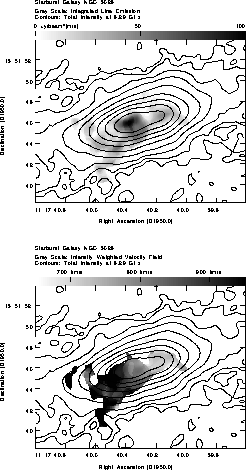 3.5cm from 9 of 14 starburst galaxies using the
VLA and the ATCA, and successfully imaged the velocity field within
several hundred parsecs of the centers of these starburst galaxies (see
Fig. 4.1).
3.5cm from 9 of 14 starburst galaxies using the
VLA and the ATCA, and successfully imaged the velocity field within
several hundred parsecs of the centers of these starburst galaxies (see
Fig. 4.1).
The theory of extragalactic radio recombination lines (RRLs) has
predicted for almost 20 years that we should be able to
detect RRLs from galaxies and QSOs.
The lines are expected to probe physical conditions in ionized gas
around the nuclei of starburst galaxies and AGN's. The first
detection of RRLs from two galaxies beyond the Magellanic Clouds
(M82 and NGC253)
were made in 1977. Despite
many efforts no further detections were made until 1991, when a line
was detected from NGC 2146 at mm wavelengths.
In 1993, Anantharamaiah et al.
detected RRLs at  3.5cm from 9 of 14 starburst galaxies using the
VLA and the ATCA, and successfully imaged the velocity field within
several hundred parsecs of the centers of these starburst galaxies (see
Fig. 4.1).
3.5cm from 9 of 14 starburst galaxies using the
VLA and the ATCA, and successfully imaged the velocity field within
several hundred parsecs of the centers of these starburst galaxies (see
Fig. 4.1).

Figure 4.1: H92 images of the nuclear region in NGC 3628 made from the
VLA observations by combining C and B configuration data; the angular
resolution is
images of the nuclear region in NGC 3628 made from the
VLA observations by combining C and B configuration data; the angular
resolution is  . (upper) integrated H92
. (upper) integrated H92 line emission (grey scale) and continuum emission at
line emission (grey scale) and continuum emission at  3.5cm
(contours). (lower) the intensity-weighted velocity field (grey
scale) and continuum emission at
3.5cm
(contours). (lower) the intensity-weighted velocity field (grey
scale) and continuum emission at  3.5cm (contours ).
3.5cm (contours ).
These detections open a new field of research. The strong radio continuum radiation from radio galaxies and quasars will make it possible to detect stimulated recombination line emission out to a large redshift, providing a unique tool for exploring the dynamics of the central regions of AGN's. Starburst galaxies will be detectable to several hundred Mpc.
The detected lines have widths of 300 to 700 km/s and line to
continuum ratios of 1% to 0.1%. Clearly the past
failures to detect these lines were mainly due to poor spectral
dynamic range. The enhanced VLA will be especially suited to
this work. The required spectral dynamic of  to 1
should be achievable with the replacement of the wave guide by optical
fibers. The possibility to cover a total bandwidth of 1 GHz (two IFs)
is especially interesting, since many different transitions fall
within 1 GHz. For example, at 2.76 GHz, 20 different transitions can be
observed within 1 GHz and as many as 50 at 1.42 GHz. These bands
are especially suitable for searches for stimulated emission.
To improve sensitivity a combined profile could be made of all the
transitions, or alternatively, if line intensity ratios
can be obtained from adjacent transitions, it will become possible to
differentiate between stimulated and spontaneous emission.
to 1
should be achievable with the replacement of the wave guide by optical
fibers. The possibility to cover a total bandwidth of 1 GHz (two IFs)
is especially interesting, since many different transitions fall
within 1 GHz. For example, at 2.76 GHz, 20 different transitions can be
observed within 1 GHz and as many as 50 at 1.42 GHz. These bands
are especially suitable for searches for stimulated emission.
To improve sensitivity a combined profile could be made of all the
transitions, or alternatively, if line intensity ratios
can be obtained from adjacent transitions, it will become possible to
differentiate between stimulated and spontaneous emission.